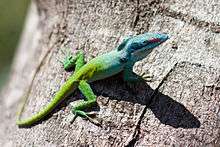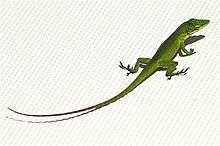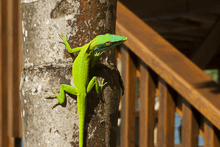Anolis carolinensis anole series
The Anolis carolinensis series is a proposed clade or subgroup of closely related mid-sized trunk crown anoles (US: /əˈnoʊ.liz/ (![]()
| species name | image | description | distribution |
|---|---|---|---|
| Carolina ("green") anole (Anolis carolinensis) |
_with_red_throat_expanded.jpg) |
Male: head and body bright green; white throat and underside; red dewlap.
Female: overall bright green with white throat and underside; dorsal white bar or diamond pattern running down the length of the back; dewlap is reduced or absent |
North Carolina, South Carolina, Georgia, Florida, and the Gulf Coast in Alabama, Mississippi, Louisiana, and Texas. The species has been introduced into Hawaii and the Ogasawara Islands. |
| Cuban green anole (Anolis porcatus) |
.jpg) |
male- head and body green with white speckels on body, throat and underside white with red dewlap. female-overall bright green with white throat and underside and dorsal white bar or diamond pattern running down the length of the back, dewlap is reduced or absent |
Cuba, Hispaniola, Dominican Republic and Isla de la Juventud. Introduced to parts of Florida. |
| Allison's anole (Anolis allisoni) |
 |
male- head, forelimbs and upper body bright blue, lower body bright green white throat and underside with red dewlap. female-bright green overall with white throat and underside and reduced or absent dewlap. |
Cuba, Honduras, Half Moon Caye and possibly Mexico. |
| Bahamian green anole (Anolis smaragdinus) |
 |
male-head green with bright electric blue speckles, body green with white throat and light green underside. bright red dewlwap. female- head and body bright green with pale green underside and white throat. Dewlap reduced or absent. | Bahamas (Cat Island), Exuma, Little San Salvador. |
List of A. carolinensis clade species
- Anolis allisoni – Allison's anole
- Anolis altitudinalis
- Anolis brunneus
- Anolis carolinensis – Carolina anole, American green anole
- Anolis fairchildi
- Anolis incredulus
- Anolis isolepis
- Anolis longiceps
- Anolis maynardi
- Anolis oporinus
- Anolis porcatus – Cuban green anole
- Anolis smaragdinus – Bahamian green anole
- Anolis toldo
Origin
Many species of the carolinensis subgroup are remarkably obscure and, with the exception of a few species such as A.carolinensis, very little is known about its members or its origin. However, it is believed that the clade originated on Cuba (Glor 2005), with repeated overwater dispersion leading to multiple speciation events. It is believed that at least four separate speciation events would have been necessary to explain the diversity found within the Carolinensis subgroup; however, the origin of several species such as A.longiceps, A.brunneus and A.maynardi has not been fully understood.[2] It is believed that the last common ancestor of the Carolinensis subgroup evolved approximately six million years ago; molecular dating currently supports this theory.[2]
The sister subgroup to the carolinensus subgroup is the isolepis group, with three species (Glor 2005).
Morphology
In many respects the anoles of the Anolis carolinensis clade are typical trunk-crown anoles. They have a slender build, have large subdigital toe-pads to cling to vertical surfaces, are commonly found several metres above the ground and with the exception of A. brunneus and A. allisoni, are usually predominantly green in coloration to blend in with the vegetation in the canopy. The most notable morphological difference between the anoles of the Carolinensis clade and the rest of the genus Anolis is that Carolinensis group anoles typically have large, conspicuously elongated heads and extreme levels of sexual dimorphism.
Both these features are most pronounced in species found on small islands rather than on large landmasses such as Cuba and North America. One such species, Anolis maynardi, reaches the highest recorded level of facial elongation among anoles, and one of the highest levels of sexual dimorphism among iguanid lizards. The reason for the extreme levels of facial elongation in the Carolinensis anole species is not yet understood; however, it is worth noting that it is only males that reach these extreme levels of facial elongation.
Distribution
Anoles of this clade are primarily found on Cuba, where it is believed that the clade originated; however, the anoles of this subgroup are also native to several neighboring islands or territories such as Honduras (A. allisoni) and Hispaniola (A. porcatus). Several species are found exclusively on small islands neighbouring Cuba such as Navassa (A.longiceps) and the Cayman islands (A.maynardi).[2]

Anolis carolinensis is native to the United States but has been introduced to areas of Japan. The Carolinensis group anole Anolis porcatus has also been introduced to parts of Florida.
References
- Kristen A. Nicholson; Brian I. Crother; Craig Guyer; Jay M. Savage (11 September 2012). "It is time for a new classification of anoles (Squamata:Dactyloidae)" (PDF). Zootaxa. Magnolia Press. p. 38. Retrieved 19 May 2013.
- Thomas Sanger. "Anole Annals.org". species diversity and biogeography among Carolinensis group anoles. Wordpress.org. Retrieved 18 May 2013.